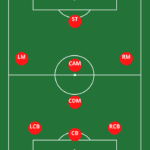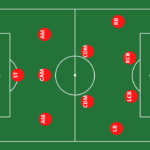- Last Updated -

Soccer, known as the beautiful game worldwide, has seen various changes to its rules over the years, reflecting the sport’s dynamic nature. One of the aspects that has undergone significant transformation is the substitution rule.
Here, we delve deep into the world of soccer substitutions, exploring its evolution, current state, strategic implications, and the differences in rules for professional and youth games.
Evolution of Soccer Substitution Rules
Soccer substitution rules have undergone considerable changes since the sport’s inception. Traditionally, in professional soccer games such as the English Premier League, only three substitutions were allowed per team during a game.
However, the coronavirus epidemic of 2020 sparked a revision of this rule in many leagues, leading to an increase in allowable substitutions, primarily to better accommodate players’ health and safety. In 2021, lawmakers recommended permanently allowing five substitutions per team during a game. [1]
Current Rules for Soccer Substitution
Today, in a standard 90-minute professional soccer game, a team can make a maximum of five substitutions on three separate occasions plus an additional opportunity at halftime. These changes aim to give players a better chance of recovery and ensure a high level of play during the match.
Concussion Substitutions
In light of the increasing awareness around player safety and particularly concerns about head injuries, concussion substitutions have been introduced. A concussion substitution does not count towards the number of substitutions allowed in a match.
In situations where the number of named substitutes matches the maximum number of substitutions allowed, the concussion substitute could even be a player previously substituted out of the match [2].
Substitution Strategy in Professional Soccer
Substitutions are not just about player fatigue or injuries; they are also a crucial aspect of match strategy. Teams might substitute players to change the dynamics of the game, bring in fresh energy, or adjust tactics in response to the opponent’s gameplay.
With the new substitution rules, coaches have more flexibility to implement their strategic plans during the match.
Goalkeeper Substitutions
Soccer substitution rules apply uniformly across outfield players and goalkeepers. The rules for introducing or replacing goalkeepers in or out of a game are the same as for outfield players. It is, however, important to note that head coaches rarely substitute their goalkeepers unless absolutely necessary [7].
Comparing Professional and Youth Soccer Substitution Rules
Substitution rules can vary considerably between professional and youth soccer. Generally, professional soccer does not permit return substitutions, which means that once a player is substituted out of the match, they can’t return to the same game.
On the other hand, youth soccer allows for more flexibility, with some leagues permitting return substitutions to encourage player rotation and development.
Conclusion
Soccer substitution rules have evolved substantially over the years, mirroring the sport’s overall progression. With a move from three to five substitutions in professional soccer, there’s a marked emphasis on player health, safety, and strategic gameplay.
Understanding these rules is crucial, as they shape the game’s flow and can significantly impact the game’s outcome. However, always remember that the implementation of these rules may vary based on the specific league or age group involved.
Frequently Asked Questions
How many substitutions are allowed in a professional soccer match?
As of the 2022/2023 season, a professional soccer team can make up to five substitutions during a match.
What are concussion substitutions in soccer?
Concussion substitutions are a new rule addition, allowing a substitute for a player suspected of a concussion. This substitution does not count towards the standard number of substitutions allowed in a match.
Can a substituted player return to the field?
In professional soccer, return substitutions are not allowed. Once a player is replaced, they cannot return to the same match.
How are goalkeeper substitutions handled?
Goalkeeper substitutions follow the same rules as those for outfield players. Coaches will rarely substitute goalkeepers unless it’s necessary.
Are substitution rules the same for youth and professional soccer?
No, substitution rules can differ between youth and professional soccer. Unlike professional soccer, some youth soccer leagues permit return substitutions.
Box-to-Box Center Midfielder: The Engine of Modern Soccer Teams
Soccer is a game of skill, strategy, and teamwork. Every player has...
Read More



















